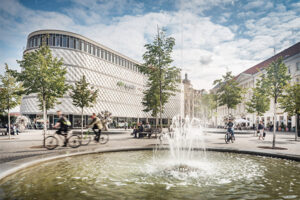A boom is spilling merrily across the globe: Online retail continued its worldwide growth trend last year. Sales rose by a fifth to over $800 billion, according to the current edition of the “A.T. Kearney Global Retail E-Commerce Index.” The experts from the international management consulting firm reviewed the size of the online market, consumer behavior, infrastructure, and growth potential for the study. They identified the US as the country with the greatest potential for online shopping. They thus pushed China from the top of the ranking to number two. Next in line comes the UK. Germany ranked fifth and France sixth. In Latin America, Mexico jumped to 17th place, while Brazil and Argentina suffered heavy losses due to their weak economies.
The study also found four overarching themes: the need for omni-channel strategies, internationalization, the growing number of e-commerce IPOs – and the continuously networked consumer, who increasingly uses a mobile device for shopping. Therefore m-commerce seems to have a bright future – i.e. shopping via smartphone, tablet, etc. Bricks-andmortar retail is and will remain the preferred distribution channel, however. Mirko Warschun, a partner at A.T. Kearney and Head of Consulting for the Consumer Products Industry and Retail in EMEA, adds perspective: “Without a doubt, online retail offers tremendous growth opportunities for retailers. The future of the industry is not in the online business, however, but in creative omni-channel offerings that combine online shopping and traditional shopping.”
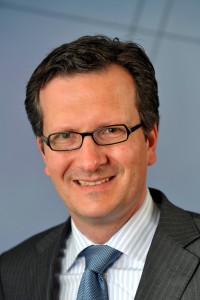
MIRKO WARS CHUN, Partner at A.T. Kearney and Head of Consulting for the Consumer Products Industry and Retail in EMEA: “The future of the industry is not in the online business, however, but in creative omni-channel offerings that combine online and traditional shopping.”
MORE SPONTANEOUS PURCHASES
Both e- and m-commerce will benefit from the fact that online payment methods are becoming safer. In many emerging countries, the internet is now regarded as the safest and fastest way to purchase products from internationally branded companies. Global shipping and fulfillment processes are getting better, too. Companies like Borderfree support retailers in shipping worldwide and offer help with currency conversion, customs, and returns.
Speaking of secure online payment methods: They are one reason why approximately 139.5 million Europeans now shop with their smartphones, according to a survey by the global financial group ING. 42% of users say that they do this regularly and spontaneously. The shopping charts are topped by clothing, at 23%, followed by electronics (21%), and toys (12%). ING adds that the growing enthusiasm for the mobile management of money transfers also means that less cash is being used throughout Europe.
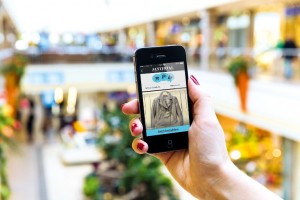
ECE became the first German shopping center operator to launch a so-called “Click & Collect” service in both its “Future Labs” malls in Hamburg and Essen in the middle of last year.
INCREASED SALES THANKS TO THE “WE BUBBLE” APP
No wonder, then, that shopping center owners and operators want to take a bite out of this mobile shopping cake. But how? Eczacibasi Holding and Is Real Estate, the owner of the Kanyon shopping center in Istanbul, developed the “We bubble” app for this purpose. In 2014, it succeeded in becoming a finalist for the ICSC Solal Marketing Awards in the category “New Media Categories – Emerging Technologies.” The app encourages customers to “catch” bubbles to obtain special offers from participating retailers. The successful campaign more than tripled the targeted number of users, generating nearly 1,200 retail coupons and realizing a 15% increase in sales in Kanyon.
ECE became the first German shopping center operator to launch a so-called “Click & Collect” service in both its “Future Labs” malls in Hamburg and Essen in the middle of last year. Products can now be viewed, bought and paid for, using an existing center app. Goods can be collected on the same day or later in the respective shop in the mall.More than 40 tenants are participating in this pilot project, including big names like Saturn, Bang & Olufsen, WMF, Lloyd, Wolford, and Napapijri. Center vouchers that can be redeemed in all ECE malls in Germany can also be used to buy online with the app.
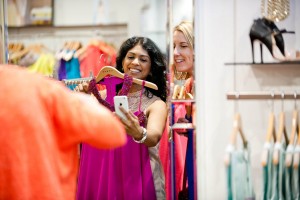
There is a growing appetite from consumers for technology that inspires and enhances the shopper’s journey through the mall, for example avoiding the need to try clothing on by using virtual mirrors.
THE BEACONS ARE COMING
But the innovations continue – even beyond apps – and some European shopping center operators are venturing into newer realms: They are installing so-called “beacons.” These beacons are small transmitters based on Bluetooth Low Energy that are installed around the center. These stations send messages to customers’ smartphones via Bluetooth as soon as they are in the vicinity. If a customer has the respective mall’s app on his smartphone, the program can scan previous purchases and send the customer related new offers.
But what good is the trendiest smartphone or tablet when its battery is dead? intu Properties in the UK is therefore putting the horse before the cart: Free-to-use, secure, phone chargers are being installed in all its malls in the largest shopping center roll-out by ChargeBox, the world’s leading out-of-home mobile phone charging company. The boxes were tested in four malls – Bromley, Merry Hill, Metrocentre, and Trafford Centre – during November and December last year. Feedback was overwhelmingly positive, encouraging a national roll-out. The trial meant into Properties could fully gauge the popularity and it indicated customers carried on shopping or relaxed in a coffee shop while their phones charged, adding to dwell times for existing retailers and restaurants. Across the 15 centers, the company will provide the capacity to charge one million mobile phones per year. Each securely locked charger box has a choice of connectors and works with most Apple, Android, and Windows phones. The phone chargers will ensure customers continue to benefit from retailers’ bricks-and-clicks strategies throughout their visit. It also gives customers another reason to travel from farther away and stay longer.
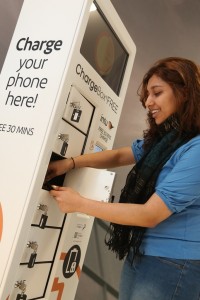
intu Properties now installs free-to-use, secure, phone chargers in all its malls. The boxes ensure that customers continue to benefit from retailers’ bricks-and-clicks strategies throughout their visits.
CONSUMERS IN “MACHINE MODE”
Against this background, Myf Ryan, Director of Marketing at Westfield UK & Europe, says pointedly: “Technology is driving the retail experience, with the majority of consumers going into ‘Machine Mode’ when shopping. They are treating their mobiles and tablets as life support machines and, if their supply is cut off, they walk away. It is also evident that technology helps to drive sales, with over a third of 14 to 34-year-olds saying new technology in-store would encourage them to spend more.” This is one of the findings of the report “How we shop now,” which Westfield published last year. Mobile devices should therefore not only boost sales. Rather, they should make visitors’ overall time at the mall as comfortable as possible. Ryan explains: “Our research shows there is a growing appetite from consumers for technology that inspires and enhances the shopper’s journey, whether that’s avoiding the need to try things on by using virtual mirrors or making purchases through their e-wallets.” This also includes the introduction of a newly developed Express parking system at Westfield London, which uses Radio-Frequency Identification (RFID) Tags so the visitor will never need a coin or ticket again.
The fact is that mobile shopping will be standard in shopping centers in the medium term. In order to generate sales in this way, there is no avoiding shops that are suitably equipped technologically. The driver is usually the customer, who can’t keep his hands off their digital toys. They must be reached and provided with the corresponding services.
